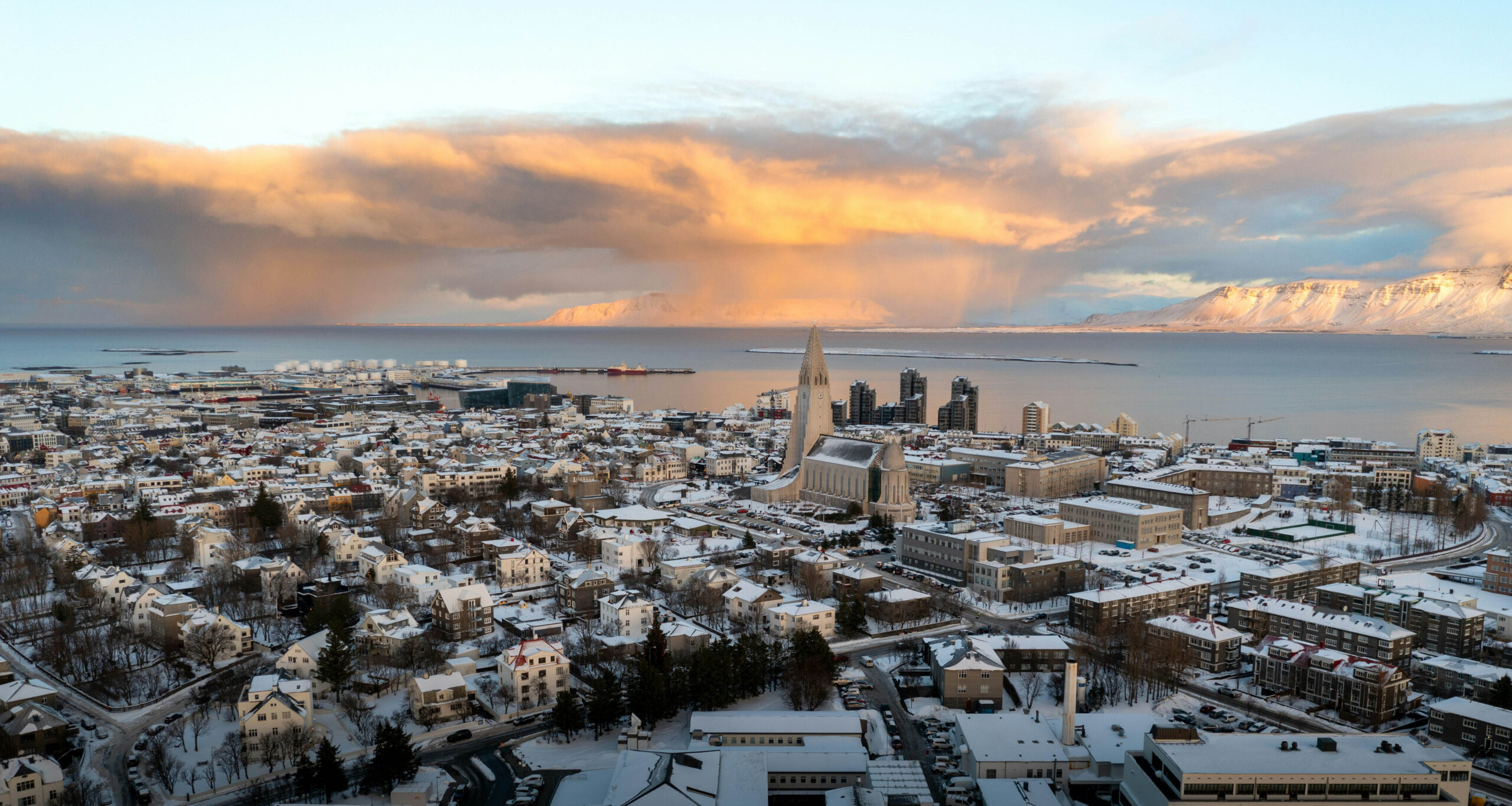The Magic of Icelandic Winter
Some winters feel harsh. In Iceland, they feel poetic.
Reykjavik in winter is quiet, bright with snow, and filled with the soft glow of candles in every window. The city might be small, but it’s surrounded by landscapes that look like another planet — frozen waterfalls, steaming geysers, and sky-wide auroras that turn night into art.
Here, you don’t rush. You breathe. You soak in hot water while snowflakes fall around you. You watch the lights dance above your cabin roof. You feel alive.
Reykjavik: Small, Creative, and Cozy
The Icelandic capital is one of the world’s smallest capitals — but also one of the most creative. In winter, its streets shine with fairy lights and murals, cafés play indie music, and locals wear wool sweaters instead of suits.
Start your day with a walk along Laugavegur, the main shopping street, lined with boutiques and record stores. Stop at Reykjavik Roasters or Kaffihús Vesturbæjar for a cinnamon bun and a flat white.
Visit Hallgrímskirkja, the city’s iconic church — you can climb the tower for a panoramic view of snow-covered roofs leading to the ocean. Then explore the Harpa Concert Hall, whose glass walls reflect the winter light like crystal.
When night comes, the city slows down beautifully — bars fill with warm light, jazz plays softly, and the northern lights sometimes appear even from downtown.
The Northern Lights Experience
Between late September and early April, the aurora borealis becomes Iceland’s main attraction.
To see it best, drive a bit outside the city — to Grótta Lighthouse, Thingvellir National Park, or Öskjuhlíð Hill. On clear nights, green ribbons swirl across the sky, sometimes pink or violet at the edges.
Locals call it “nature’s fireworks,” and that’s exactly what it feels like. Bring a thermos of hot chocolate, dress warmly, and let time stop.
The Warm Heart of Iceland: Hot Springs & Spas
There’s nothing more Icelandic than soaking in hot water while snow falls around you.
The most famous is the Blue Lagoon, just 45 minutes from Reykjavik. Its milky-blue geothermal pools surrounded by lava rocks are world-famous for a reason. Go early in the morning or at sunset for fewer crowds.
If you prefer something smaller and local, try Sky Lagoon, a modern spa on the edge of the city with infinity pools overlooking the sea. Its 7-step ritual — sauna, cold plunge, salt scrub — is the perfect reset for winter days.
And for a true adventure, drive to Reykjadalur Hot River, where you can bathe in a natural warm stream after a short hike through snowy hills.
Where to Stay
Icelandic winter is all about comfort — think wood cabins, big windows, and fireplaces.
- ION Adventure Hotel – futuristic design and perfect for northern lights.
- Panorama Glass Lodge – private cabins with glass roofs for sky watching.
- The Reykjavik EDITION – luxury by the harbor, close to everything.
- Kvosin Downtown Hotel – modern apartments with a homely feel.
- Camp Boutique Original – glamping meets design, for something different.
If you stay outside the city, you’ll see more stars and more silence.
What to Eat
Icelandic cuisine is hearty and honest — made for cold weather.
Try:
- Lamb soup (kjötsúpa) – slow-cooked and full of flavor.
- Arctic char – grilled or smoked, light and buttery.
- Rye bread from a hot spring – baked underground by geothermal heat.
- Skyr – thick Icelandic yogurt with berries and honey.
For dinner, visit Grillmarkaðurinn or Fiskfélagið for modern Nordic dishes, or Íslenski Barinn for local comfort food.
And yes, Icelandic hot dogs are iconic — especially from Bæjarins Beztu Pylsur, open since 1937.
Day Trips Worth Taking
Golden Circle – the classic loop that includes Þingvellir National Park, Geysir, and Gullfoss waterfall. All three look stunning under snow.
South Coast – waterfalls like Seljalandsfoss and Skógafoss, black-sand beaches in Vík, and views of glaciers.
Snæfellsnes Peninsula – often called “Iceland in Miniature,” with lava fields, cliffs, and tiny fishing villages.
Winter driving is safe if you rent a 4×4 and check road conditions — but AITINERY can help you design routes that match your comfort level.
The Rhythm of Icelandic Winter
Days are short — sometimes only 4–5 hours of daylight — but that’s part of the magic. You wake slowly, explore softly, and spend evenings in warmth. Locals fill their homes with candles, books, and laughter.
It’s a lifestyle built around light and coziness — or as they call it, hygge’s northern cousin.
Travel Tips
- Best time to visit: November to March.
- Temperature: –2 °C to +3 °C.
- Currency: Icelandic króna (ISK).
- Language: Icelandic, but everyone speaks English.
- Budget: about €200–€300/day.
- Packing list: thermal layers, waterproof boots, hat, gloves, swimsuit (yes!).
Sustainable Travel
Iceland’s nature is fragile. Stick to marked trails, avoid off-road driving, and respect geothermal sites. Many hotels run entirely on renewable energy — one more reason to love this country.
Buy handmade wool sweaters (lopapeysa) directly from local markets, not mass shops. And remember: take nothing but photos, leave nothing but footprints.
Plan Your Icelandic Winter with AITINERY
Whether you dream of watching northern lights in Reykjavik, soaking in hot springs, or road-tripping across snowy Iceland — AITINERY helps you plan every moment.
With AITINERY, you can:
- Build routes of any complexity — from cozy weekends to full Arctic adventures.
- Combine cities, nature, and wellness experiences in one plan.
- Discover AI-powered travel ideas tailored for winter.
- Adjust everything — hotels, activities, and timing — to your rhythm.
Iceland in winter feels otherworldly — and AITINERY helps you capture its magic, step by step.
👉 Start creating your dream route now at aitinery.com.

